Decarbonising Island Kitchens: Assessing the Small-Scale Flexible Balloon Digester’s Clean Cooking Potential in Fiji
Abstract
1. Introduction
2. Materials and Methods
2.1. Bench Experiment
2.2. Home Biogas 2.0 Experimentation
Home Biogas 2.0
2.3. Estimation of Biogas Volume
2.4. Energy Content of Generated Biogas
2.5. Economic Analysis
2.5.1. Net Present Value (NPV)
2.5.2. Internal Rate of Return (IRR)
2.5.3. Benefit Cost Ratio (BCR)
2.5.4. Payback Time (PB)
2.5.5. Discounted Payback Period (DPBP)
2.6. Avoided Carbon Emissions
3. Results
3.1. Comparison of Biogas Production from Bench Experiments
3.2. Optimising Biogas Production from Kitchen Waste
3.3. Case Study of Home Biogas 2.0
3.3.1. Home Biogas Case Study 1—Vegetable Waste Substrate
3.3.2. Home Biogas Case Study 2—Fresh Cow Dung Substrate
3.4. Economic Analysis Outcomes
3.4.1. Using Theoretical Values Estimation Approach
3.4.2. Economic Analysis for Biogas Generation from Kitchen Vegetable Waste
3.4.3. Economic Analysis for Biogas Generation from Fresh Cow Dung
3.5. Sensitivity Analysis
3.6. Economic Analysis Considering Income from Liquid Digestate
3.7. Estimated Carbon Emission Reduction
4. Discussion
5. Conclusions
Author Contributions
Funding
Data Availability Statement
Acknowledgments
Conflicts of Interest
References
- Achakulwisut, P.; Erickson, P.; Guivarch, C.; Schaeffer, R.; Brutschin, E.; Pye, S. Global fossil fuel reduction pathways under different climate mitigation strategies and ambitions. Nat. Commun. 2023, 14, 5425. [Google Scholar] [CrossRef] [PubMed]
- REN 21. Renewables 2024 Global Status Report Collection, Global Overview. 2024. Available online: https://www.ren21.net/gsr-2024/modules/global_overview/ (accessed on 1 July 2025).
- Energy Fiji Limited. 2023 Annual Report. 2023. Available online: https://www.parliament.gov.fj/wp-content/uploads/2024/07/69-Energy-Fiji-Limited-Annual-Report-2023.pdf (accessed on 1 July 2025).
- Government of Fiji. Republic of Fiji National Energy Policy 2023–2030; Ministry of Public Works, Meteorological Services, and Transport (MPWMST): Suva, Fiji, 2022.
- Michalena, E.; Kouloumpis, V.; Hills, J.M. Challenges for Pacific Small Island Developing States in achieving their Nationally Determined Contributions (NDC). Energy Policy 2018, 114, 508–518. [Google Scholar] [CrossRef]
- Sheikh, A.Z.; Kumar, A. Evaluating Biomass Briquettes as a Clean Cooking Fuel Alternative in Fiji. SSRN. 2024. Available online: https://ssrn.com/abstract=5201001 (accessed on 1 July 2025). [CrossRef]
- Vassiliades, C.; Diemuodeke, O.E.; Yiadom, E.B.; Prasad, R.D.; Dbouk, W. Policy Pathways for Mapping Clean Energy Access for Cooking in the Global South—A Case for Rural Communities. Sustainability 2022, 14, 13577. [Google Scholar] [CrossRef]
- Prasad, R.D.; Dbouk, W.; Yiadom, E.B.; Vassiliades, C. Biogas digester innovations as solution to clean cooking energy challenge in the Pacific Islands: A policy perspective. Energy Rep. 2025, 13, 2417–2432. [Google Scholar] [CrossRef]
- Chandra, V.; Hemstock, S. A biomass energy flow chart for Fiji. Biomass Bioenergy 2015, 72, 117–122. [Google Scholar] [CrossRef]
- Greco, C.; Comparetti, A.; Orlando, S.; Mammano, M.M. A contribution to environmental protection through the valorisation of kitchen biowaste. In Safety, Health and Welfare in Agriculture and Agro-Food Systems. SHWA 2020; Biocca, M., Cavallo, E., Cecchini, M., Failla, S., Romano, E., Eds.; Lecture Notes in Civil Engineering (LNCE); Springer International Publishing: Cham, Switzerland, 2022; Volume 252, pp. 411–420. [Google Scholar]
- Nadan, M.K.; Baroutian, S. Prospective of pretreatment and anaerobic digestion of dairy cow manure in Fiji. J. Chem. Technol. Biotechnol. 2023, 98, 1584–1597. [Google Scholar] [CrossRef]
- Attard, G.; Azzopardi, N.; Comparetti, A.; Greco, C.; Gruppetta, A.; Orlando, S. Potential Bioenergy and Biofertiliser Production from Livestock Waste in Mediterranean Islands Within Circular Bioeconomy. Conference of the Italian Society of Agricultural Engineering. In AIIA 2022: Biosystems Engineering Towards the Green Deal; Ferro, V., Giordano, G., Orlando, S., Vallone, M., Cascone, G., Porto, S.M.C., Eds.; Lecture Notes in Civil Engineering; Springer International Publishing: Cham, Switzerland, 2023; Volume 337, pp. 271–283. [Google Scholar] [CrossRef]
- Asciuto, A.; Agosta, M.; Attard, G.; Comparetti, A.; Greco, C.; Mammano, M.M. Development of an Investment Decision Tool for Biogas Production from Biowaste in Mediterranean Islands. Conference of the Italian Society of Agricultural Engineering. In AIIA 2022: Biosystems Engineering Towards the Green Deal; Ferro, V., Giordano, G., Orlando, S., Vallone, M., Cascone, G., Porto, S.M.C., Eds.; Lecture Notes in Civil Engineering; Springer International Publishing: Cham, Switzerland, 2023; Volume 337, pp. 251–262. [Google Scholar] [CrossRef]
- Comparetti, A.; Febo, P.; Greco, C.; Orlando, S.; Navickas, K.; Nekrosius, A.; Venslauskas, K. Biogas yield from Sicilian kitchen waste and cheese whey. J. Agric. Eng. 2013, XLIV, e106. [Google Scholar] [CrossRef]
- Dai, B.; Xu, J.; He, Y.; Xiong, P.; Wang, X.; Deng, Y.; Wang, Y.; Yin, Z. Acid inhibition during anaerobic digestion of biodegradable kitchen waste. J. Renew. Sustain. Energy 2015, 7, 023118. [Google Scholar] [CrossRef]
- Adeoti, O.; Ilori, M.O.; Oyebisi, T.O.; Adekoya, L.O. Engineering design and economic evaluation of a family-sized biogas project in Nigeria. Technovation 2000, 20, 103–108. [Google Scholar] [CrossRef]
- Karellas, S.; Boukis, I.; Kontopoulos, G. Development of an investment decision tool for biogas production from agricultural waste. Renew. Sustain. Energy Rev. 2010, 14, 1273–1282. [Google Scholar] [CrossRef]
- Gwavuya, S.G.; Abele, S.; Barfuss, I.; Zeller, M.; Müller, J. Household energy economics in rural Ethiopia: A cost-benefit analysis of biogas energy. Renew. Energy 2012, 48, 202–209. [Google Scholar] [CrossRef]
- Hublin, A.; Schneider, D.R.; Džodan, J. Utilization of biogas produced by anaerobic digestion of agro-industrial waste: Energy, economic and environmental effects. Waste Manag. Res. 2014, 32, 626–633. [Google Scholar] [CrossRef]
- Akbulut, A.; Arslan, O.; Arat, H.; Erbas, O. Important aspects for the planning of biogas energy plants: Malatya case study. Case Stud. Thermal Eng. 2021, 26, 101076. [Google Scholar] [CrossRef]
- Campello, L.D.; Barros, R.M.; Tiago Filho, G.L.; dos Santos, I.F.S. Analysis of the economic viability of the use of biogas produced in wastewater treatment plants to generate electrical energy. Environ. Develop. Sustain. 2021, 23, 2614–2629. [Google Scholar] [CrossRef]
- Cañote, S.J.B.; Barros, R.M.; Lora, E.E.S.; del Olmo, O.A.; Santos, I.F.S.D.; Piñas, J.A.V.; Ribeiro, E.M.; de Freitas, J.V.R.; de Castro e Silva, H.L. Energy and economic evaluation of the production of biogas from anaerobic and aerobic sludge in Brazil. Waste Biomass Valoriz. 2021, 12, 947–969. [Google Scholar] [CrossRef]
- Jellali, S.; Charabi, Y.; Usman, M.; Al-Badi, A.; Jeguirim, M. Investigations on biogas recovery from anaerobic digestion of raw sludge and its mixture with agri-food wastes: Application to the largest industrial estate in Oman. Sustainability 2021, 13, 3698. [Google Scholar] [CrossRef]
- Cudjoe, D.; Nketiah, E.; Obuobi, B.; Adu-Gyamfi, G.; Adjei, M.; Zhu, B. Forecasting the potential and economic feasibility of power generation using biogas from food waste in Ghana: Evidence from Accra and Kumasi. Energy 2021, 226, 120342. [Google Scholar] [CrossRef]
- Quadrelli, R.; Intergovernmental Panel on Climate Change. 2006 IPCC Guidelines for National Greenhouse Gas Inventories: Volume 2—Energy, Chapter 2: Stationary Combustion. Institute for Global Environmental Strategies, 2006. Available online: https://www.ipcc-nggip.iges.or.jp/public/2006gl/pdf/2_Volume2/V2_2_Ch2_Stationary_Combustion.pdf (accessed on 2 July 2025).
- Liu, Y.; Huang, T.; Peng, D.; Huang, J.; Maurer, C.; Kranert, M. Optimizing the co-digestion supply chain of sewage sludge and food waste by the demand oriented biogas supplying mechanism. Waste Manag. Res. 2020, 39, 302–313. [Google Scholar] [CrossRef]
- Al-Wahaibi, A.; Osman, A.I.; Al-Muhtaseb, A.H.; Alqaisi, O.; Baawain, M.; Fawzy, S.; Rooney, D.W. Techno-economic evaluation of biogas production from food waste via anaerobic digestion. Sci. Rep. 2020, 10, 15719. [Google Scholar] [CrossRef] [PubMed]
- Pati, A.R.; Saroha, S.; Behera, A.P.; Mohapatra, S.S.; Mahanand, S.S. The Anaerobic Digestion of Waste Food Materials by Using Cow Dung: A New Methodology to Produce Biogas. J. Inst. Eng. (India) Ser. E 2019, 100, 111–120. [Google Scholar] [CrossRef]
- Comparetti, A.; Febo, P.; Greco, C.; Orlando, S. Current state and future of biogas and digestate production. Bulg. J. Agric. Sci. 2013, 19, 1–14. [Google Scholar]
- Gyadi, T.; Bharti, A.; Basack, S.; Kumar, P.; Lucchi, E. Influential factors in anaerobic digestion of rice-derived food waste and animal manure: A comprehensive review. Bioresour. Technol. 2024, 413, 131398. [Google Scholar] [CrossRef]
- Mrosso, R.; Mecha, A.C.; Kiplagat, J. Characterization of kitchen and municipal organic waste for biogas production: Effect of parameters. Heliyon 2023, 9, e16360. [Google Scholar] [CrossRef]
- Glivin, G.; Sekhar, S.J. Studies on the Feasibility of Producing Biogas from Rice Waste. Rom. Biotechnol. Lett. 2019, 24, 728–735. [Google Scholar] [CrossRef]
- Felton, G.; Lansing, S.; MosQuas, A.; Klavon, K. Anaerobic Digestion Series. Anaerobic Digestion: Basic Processes for Biogas Production. Fact Sheet FS-994; Solutions in Your Community; University of Maryland Extension: College Park, MD, USA, October 2014; 7p. [Google Scholar]
- IEA—International Energy Agency. Outlook for Biogas and Biomethane. Prospects for Organic Growth; World Energy Outlook Special Report; IEA: Paris, France, March 2020; 93p. [Google Scholar]
- Putti, V.; Tsan, M.; Mehta, S.; Kammila, S. The State of the Global Clean and Improved Cooking Sector; Energy Sector Management Assistance Program, Global Alliance for Clean Cookstoves; World Bank: Washington, DC, USA, 2015. [Google Scholar]
- International Gas Union. Natural Gas Conversion Guide. 2012. Available online: https://www.apeg.pt/folder/documento/ficheiro/natural-gas-conversion-guide_cb4f0ccd80ccaf88ca5ec336a38600867db5aaf1.pdf (accessed on 2 July 2025).
- Fijian Competition and Consumer Commission. Price Control Order for LPG Products—12 kg Gas Cylinder. 2022. Available online: https://www.fccc.gov.fj (accessed on 3 July 2025).
- Obileke, K.; Makaka, G.; Nwokolo, N.; Meyer, E.L.; Mukumba, P. Economic Analysis of Biogas Production via Biogas Digester Made from Composite Material. ChemEngineering 2022, 6, 67. [Google Scholar] [CrossRef]
- United Nations Development Programme. From Dung to Dinner: Biogas Transforming Cooking Energy in Rwanda By Maxwell Gomera. 16 March 2023. Available online: https://www.undp.org/rwanda/blog/dung-dinner-biogas-transforming-cooking-energy-rwanda (accessed on 3 July 2025).
- Wu, D.; Peng, X.; Li, L.; Yang, P.; Peng, Y.; Liu, H.; Wang, L. Commercial biogas plants: Review on operational parameters and guide for performance optimization. Fuel 2021, 303, 121282. [Google Scholar] [CrossRef]
- Hoet, E. Digesting the Impact on Climate. Food Chain Magazine. 2022. Available online: https://foodchainmagazine.com/news/digesting-the-impact-on-climate/#:~:text=The%201.3%20gigatons%20of%20edible,times%20more%20potent%20than%20CO2 (accessed on 3 July 2025).
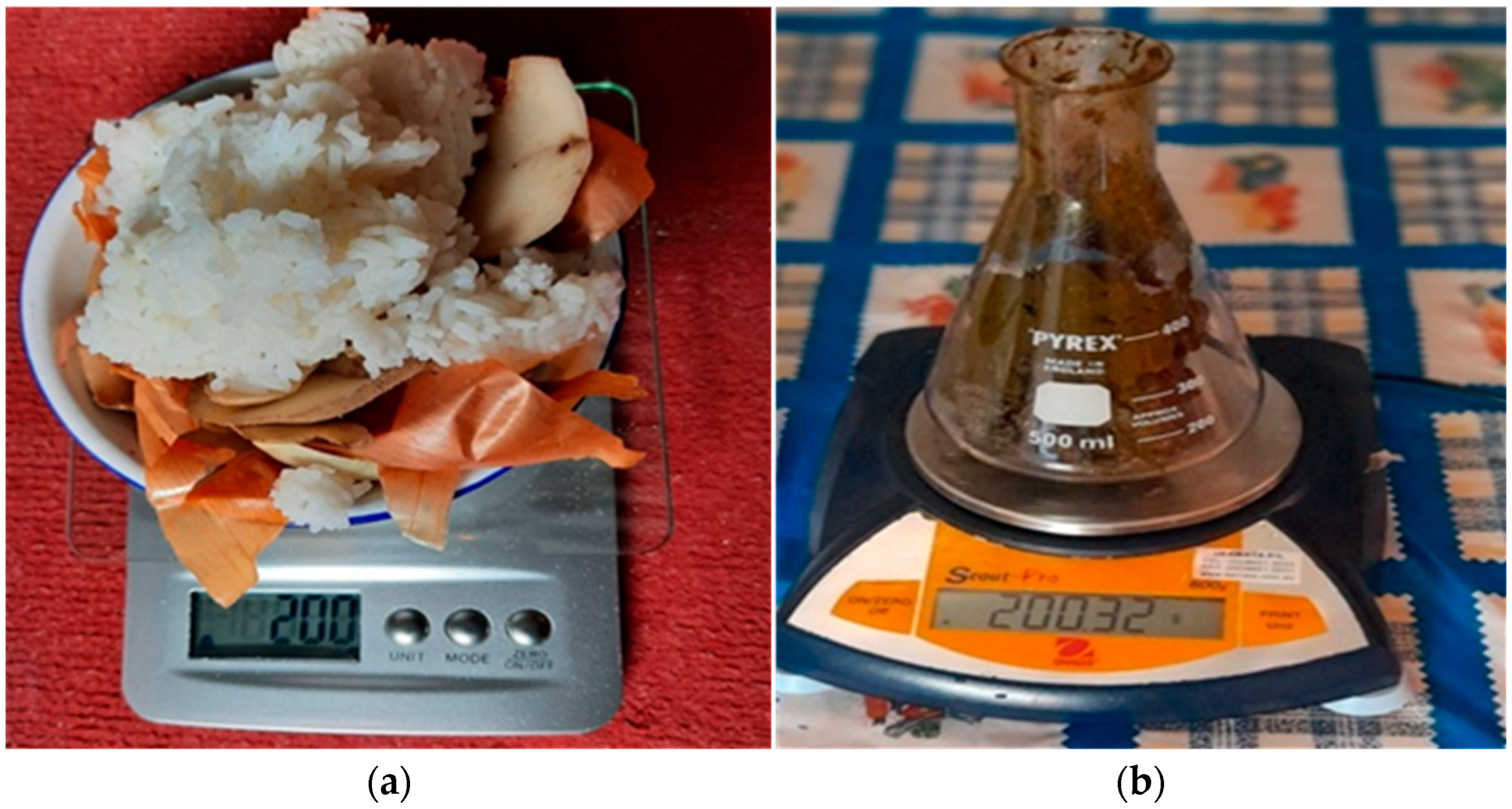
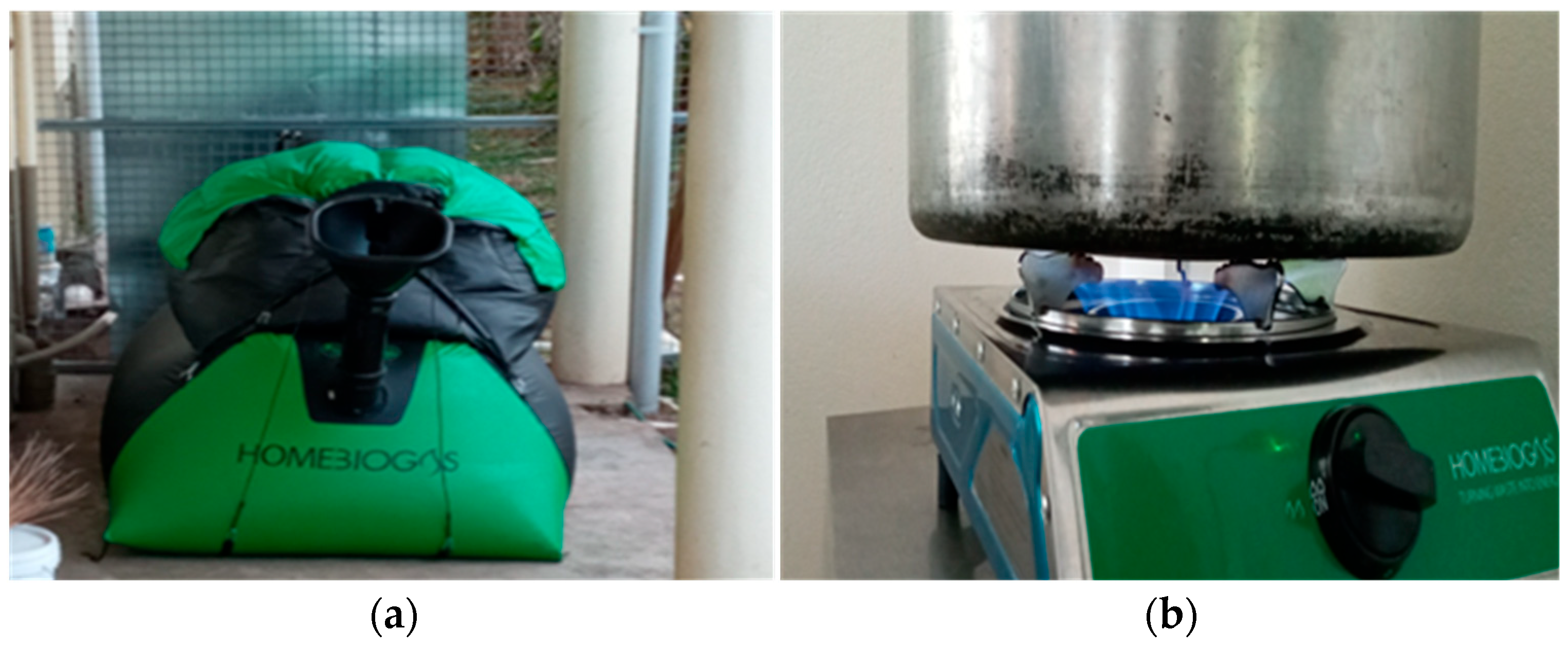

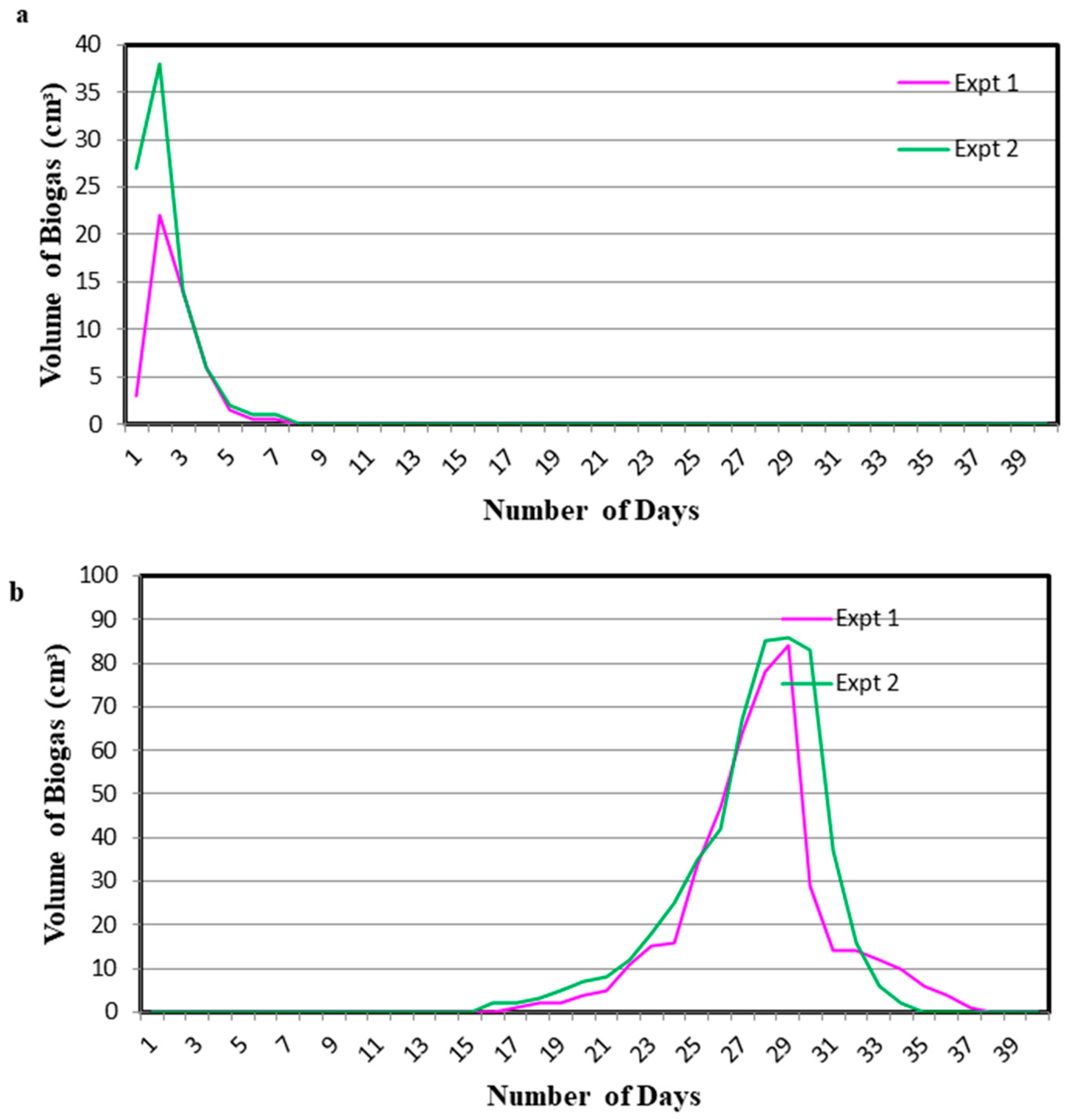
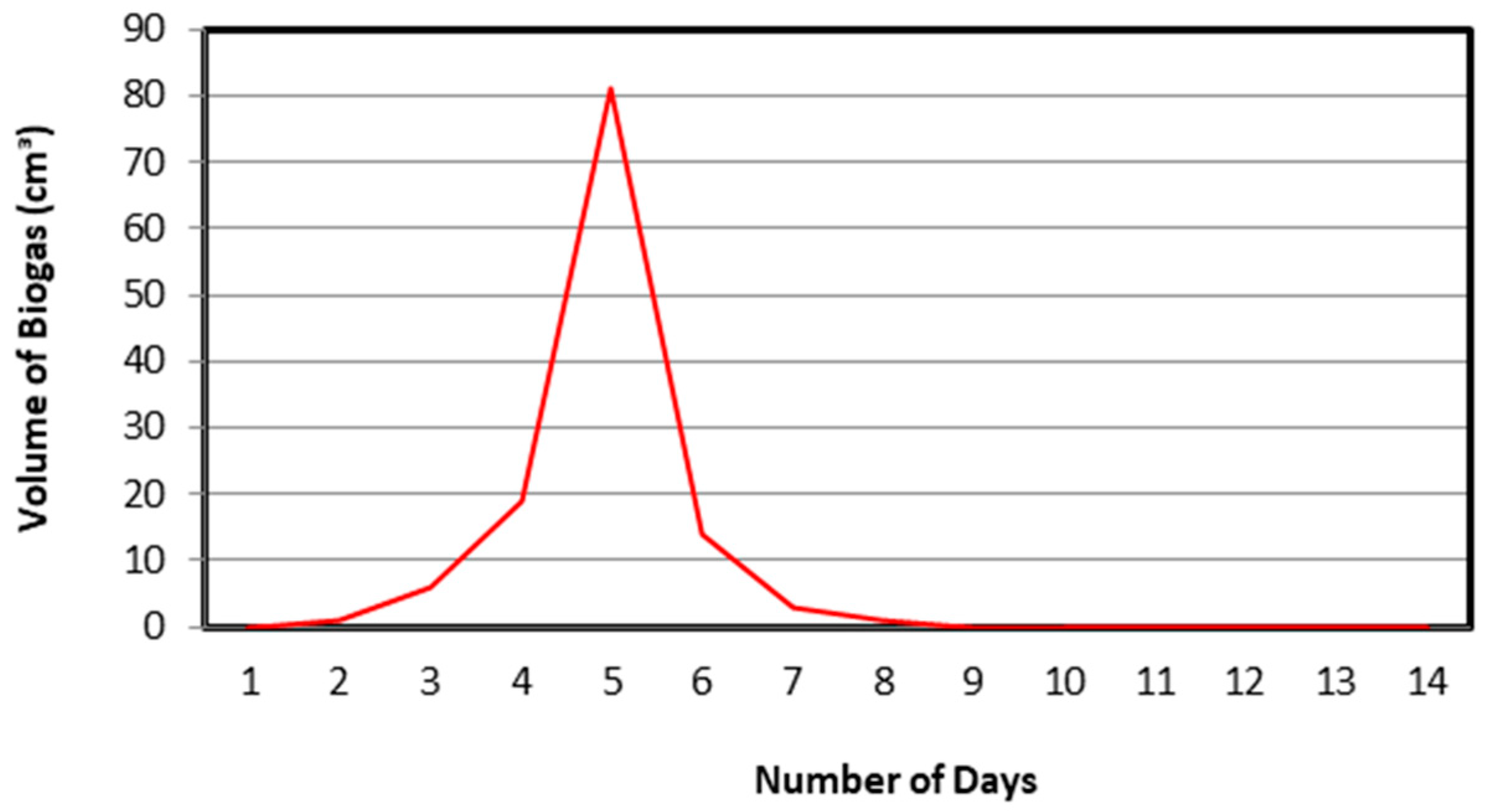
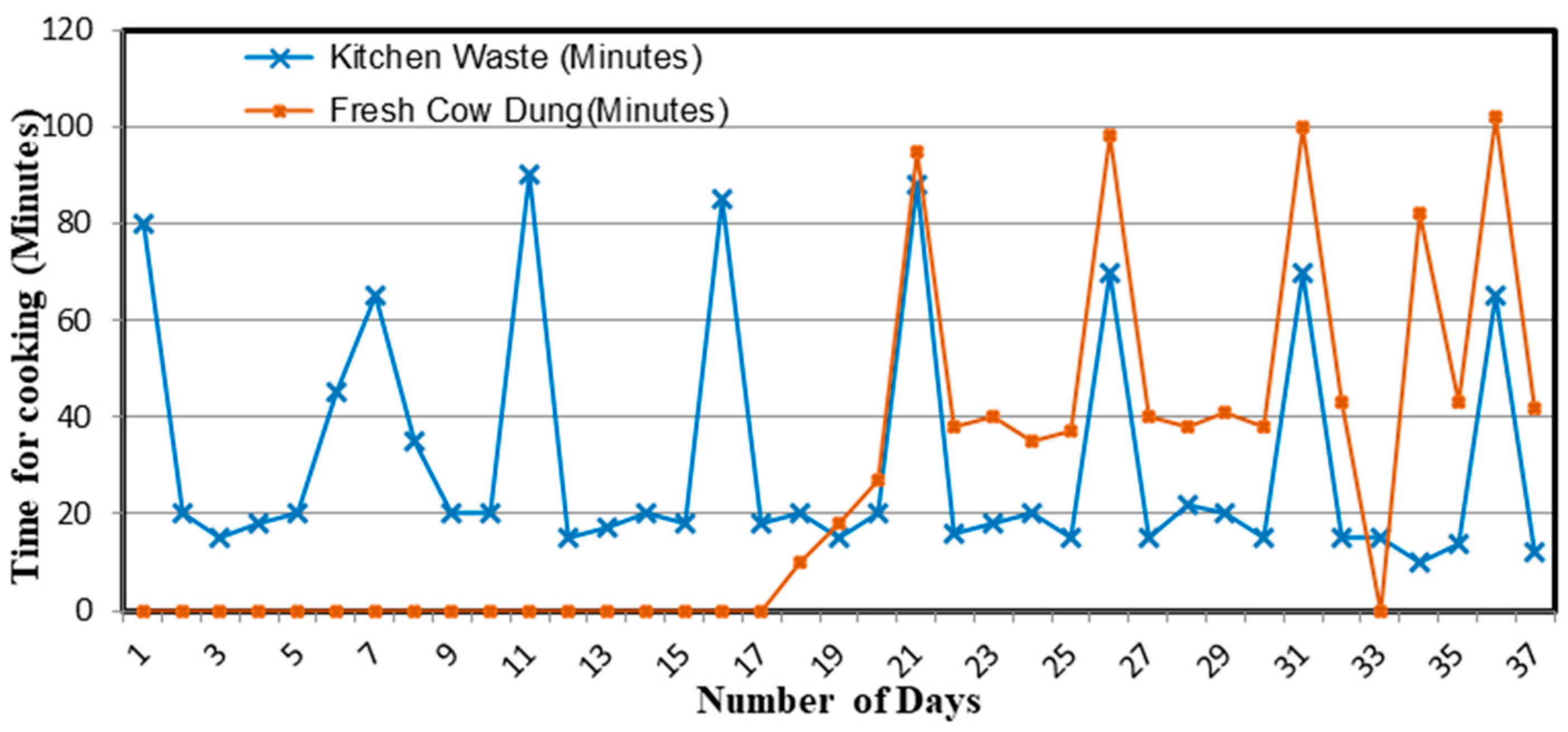

| Kitchen Waste | Quantity (g) | Animal Waste | Quantity (g) |
|---|---|---|---|
| Rice | 120 | ||
| Potato Peelings | 40 | Fresh Cow Dung | 200 |
| Onion Peelings | 40 | ||
| Total | 200 | 200 |
| Day | Date | Cooking Time (Minutes) | Content (Carbohydrates) | % | Content (Peelings) | % | Content (Vegetable Waste) | % | pH | Liquid Digestate (Liters) | Temperature (°C) |
|---|---|---|---|---|---|---|---|---|---|---|---|
| 1 | 16 May | 80 | Leftover Rice | 40 | Potato peelings | 30 | Vegetable waste | 30 | 6.9 | 4.9 | 26.7 |
| 2 | 17 May | 20 | Bread | 20 | Pumpkin peelings | 40 | Vegetable waste | 40 | 7.3 | 4.9 | 26.6 |
| 3 | 18 May | 15 | Leftover Rice | 50 | Potato peelings | 30 | Vegetable waste | 20 | 6.7 | 4.8 | 26 |
| 4 | 19 May | 18 | Leftover Rice | 20 | Potato and onion peelings | 60 | Vegetable waste | 20 | 6.9 | 4.9 | 26.2 |
| 5 | 20 May | 20 | Leftover Rice | 20 | Dalo peelings | 70 | Vegetable waste | 10 | 7.1 | 4.85 | 26.7 |
| 6 | 23 May | 45 | Leftover Rice | 30 | Potato peelings | 30 | Vegetable waste | 40 | 7.3 | 4.9 | 26.5 |
| 7 | 24 May | 65 | Leftover Rice | 5 | Potato, onion and garlic peelings | 95 | 6.5 | 4.8 | 26.9 | ||
| 8 | 25 May | 35 | Leftover Rice | 40 | Potato peelings | 30 | Vegetable waste | 30 | 6.4 | 4.8 | 27.1 |
| 9 | 26 May | 20 | Leftover Rice | 20 | Potato peelings with onion peelings | 40 | Vegetable waste | 40 | 6.7 | 4.9 | 26.6 |
| 10 | 27 May | 20 | Leftover Rice | 25 | Potato peelings | 25 | Pumpkin peelings | 50 | 6.3 | 4.9 | 26.3 |
| 11 | 30 May | 90 | Leftover roti | 50 | Potato and onion peelings | 50 | 6.5 | 4.8 | 25.9 | ||
| 12 | 31 May | 15 | Leftover Rice | 20 | Pawpaw, onion and potato peelings | 80 | 6.8 | 4.9 | 26.1 | ||
| 13 | 1 June | 17 | Leftover Rice | 25 | Pawpaw, onion and potato peelings | 75 | 6.8 | 4.8 | 26.3 | ||
| 14 | 2 June | 20 | Leftover Rice | 40 | Potato and Onion peelings | 30 | Vegetable waste | 30 | 6.8 | 4.8 | 26.1 |
| 15 | 3 June | 18 | Leftover Rice | 20 | Potato and Onion peelings | 20 | Vegetable waste | 60 | 6.8 | 4.8 | 26.3 |
| 16 | 6 June | 85 | Leftover Rice and bread | 80 | Potato and Onion peelings | 20 | 7.0 | 4.88 | 26.4 | ||
| 17 | 7 June | 18 | Leftover Palao rice and cassava | 80 | Potato peelings | 20 | 6.9 | 4.8 | 26.3 | ||
| 18 | 8 June | 20 | Leftover Bhajia and rice | 80 | Potato and Onion peelings | 20 | 6.9 | 4.8 | 25.9 | ||
| 19 | 9 June | 15 | Leftover Roti | 70 | Potato, onion and Pawpaw peelings | 20 | Vegetable waste | 10 | 6.7 | 4.8 | 26.2 |
| 20 | 10 June | 20 | Leftover bread | 30 | Potato and onion with garlic peelings | 50 | Vegetable peelings and carrot peelings | 20 | 7.1 | 4.8 | 26.1 |
| 21 | 13 June | 88 | Leftover curry and bread | 60 | Potato and Onion peelings | 40 | 6.9 | 4.85 | 26.1 | ||
| 22 | 14 June | 16 | Leftover Rice | 30 | Potato peelings | 30 | Leftover curry | 40 | 6.9 | 4.8 | 26.5 |
| 23 | 15 June | 18 | Leftover Rice | 20 | Breadfruit, potato and onion peelings | 80 | 6.8 | 4.8 | 26.6 | ||
| 24 | 16 June | 20 | Leftover Rice with curry | 80 | Potato peelings | 20 | 6.9 | 4.8 | 26.3 | ||
| 25 | 17 June | 15 | Leftover bread and rice | 70 | Potato and Onion peelings | 30 | 7.1 | 4.8 | 26.5 | ||
| 26 | 20 June | 70 | Leftover Rice | 40 | Potato peelings | 20 | vegetable peelings and carrot peelings | 40 | 7.0 | 4.8 | 26.2 |
| 27 | 21 June | 15 | Leftover Rice and bread | 60 | Potato and Onion peelings | 40 | 7.1 | 4.8 | 26.3 | ||
| 28 | 22 June | 22 | Leftover cooked cassava and bara | 80 | Potato peelings | 20 | 6.9 | 4.8 | 26.1 | ||
| 29 | 23 June | 20 | Leftover Rice and roti | 70 | Potato and Onion peelings | 30 | 6.9 | 4.7 | 26.2 | ||
| 30 | 24 June | 15 | Leftover Rice | 30 | Potato and Onion peelings | 20 | Vegetable waste | 50 | 6.9 | 4.7 | 26.5 |
| 31 | 27 June | 70 | Leftover Rice and roti | 40 | Potato and Onion peelings | 30 | Vegetable waste | 30 | 7.1 | 4.8 | 26.6 |
| 32 | 28 June | 15 | Leftover Rice | 70 | Potato peelings | 30 | 6.7 | 4.8 | 26.5 | ||
| 33 | 29 June | 15 | Leftover Rice, bread and cassava | 80 | Potato and Onion peelings | 20 | 6.8 | 4.8 | 26.5 | ||
| 34 | 30 June | 10 | Leftover Rice and bread | 70 | Potato peelings | 30 | 6.8 | 4.8 | 26.6 | ||
| 35 | 1 July | 14 | Leftover Rice and roti | 40 | Potato and Onion peelings | 40 | Vegetable peelings | 20 | 6.8 | 4.8 | 26.1 |
| 36 | 4 July | 65 | Leftover Rice and roti and fried cassava | 80 | Onion peelings | 20 | 6.8 | 4.8 | 26.5 | ||
| 37 | 5 July | 12 | Leftover Rice, bread with curry | 70 | Potato and Onion peelings | 30 | 6.8 | 4.88 | 26.4 | ||
| 38 | 6 July | 10 | Leftover Rice and cassava | 70 | Potato and Onion peelings | 30 | 6.7 | 4.85 | 26.3 | ||
| 39 | 7 July | 12 | Leftover Rice | 30 | Potato peelings | 50 | Vegetable peelings | 20 | 6.7 | 4.9 | 26.2 |
| 40 | 8 July | not used | Leftover palau, roti and bread | 70 | Potato and Onion peelings | 30 | 6.7 | 4.8 | 26.1 |
| Day | Date | Cooking Time (Minutes) | pH | Temperature (°C) | Liquid Digestate (Liters) |
|---|---|---|---|---|---|
| 1 | 25 July | 0 | 6.42 | 26.8 | 4.9 |
| 2 | 26 July | 0 | 6.36 | 26.7 | 4.9 |
| 3 | 27 July | 0 | 6.26 | 26.8 | 4.9 |
| 4 | 28 July | 0 | 6.24 | 26.9 | 4.92 |
| 5 | 29 July | 0 | 6.22 | 26.7 | 4.91 |
| 6 | 1 August | 0 | 6.62 | 26.9 | 4.85 |
| 7 | 2 August | 0 | 6.62 | 26.9 | 4.85 |
| 8 | 3 August | 0 | 6.42 | 27.1 | 4.87 |
| 9 | 4 August | 0 | 6.42 | 26.3 | 4.88 |
| 10 | 5 August | 0 | 6.32 | 27.4 | 4.8 |
| 11 | 8 August | 0 | 6.22 | 26.2 | 4.8 |
| 12 | 9 August | 0 | 6.24 | 26.1 | 4.8 |
| 13 | 10 August | 0 | 6.26 | 26.3 | 4.8 |
| 14 | 11 August | 0 | 6.22 | 27.2 | 4.75 |
| 15 | 12 August | 0 | 6.32 | 26.3 | 4.8 |
| 16 | 15 August | 0 | 6.22 | 26.4 | 4.7 |
| 17 | 16 August | 0 | 6.24 | 26.3 | 4.7 |
| 18 | 17 August | 10 | 6.26 | 25.9 | 4.75 |
| 19 | 18 August | 18 | 6.28 | 26.2 | 4.7 |
| 20 | 19 August | 27 | 6.24 | 26.1 | 4.75 |
| 21 | 22 August | 95 | 6.26 | 27.1 | 4.7 |
| 22 | 23 August | 38 | 6.28 | 26.5 | 4.7 |
| 23 | 24 August | 40 | 6.26 | 26.3 | 4.7 |
| 24 | 25 August | 35 | 6.28 | 26.7 | 4.65 |
| 25 | 26 August | 37 | 6.25 | 26.5 | 4.78 |
| 26 | 29 August | 98 | 6.28 | 26.7 | 4.7 |
| 27 | 30 August | 40 | 6.26 | 26.3 | 4.7 |
| 28 | 31 August | 38 | 6.28 | 26.5 | 4.7 |
| 29 | 1 September | 41 | 6.22 | 26.6 | 4.68 |
| 30 | 2 September | 38 | 6.26 | 26.7 | 4.7 |
| 31 | 5 September | 100 | 6.26 | 26.3 | 4.7 |
| 32 | 6 September | 42 | 6.23 | 26.4 | 4.7 |
| 33 | 7 September | Only feeding | 6.24 | 26.3 | 4.75 |
| 34 | 8 September | 88 | 6.26 | 26.3 | 4.7 |
| 35 | 9 September | 42 | 6.28 | 26.3 | 4.7 |
| 36 | 12 September | 102 | 6.32 | 26.3 | 4.75 |
| 37 | 13 September | 41 | 6.35 | 26.3 | 4.7 |
| Theoretical Specifications of the Manufacturer | Biogas Produced from Kitchen Vegetable Waste | Biogas Produced from Cow Dung | |
|---|---|---|---|
| Net Present Value (NPV) | −499.58 | −1314.53 | −919.87 |
| Internal Rate of Return (IRR) | 11% | 5% | 8% |
| Benefit/cost ratio (BCR) | 0.833 | 0.566 | 0.693 |
| Discounted payback period (DPBP) | ~14.5 years | Over 50 years | ~26.48 years |
| IRR | NPV | B/C Ratio | Discounted Pay Back Period | |
|---|---|---|---|---|
| (a) Average LPG 12 kg Cylinder Price: $45.05 | ||||
| Theoretical | 14% | $220.95 | 1.07 | 14.5 years |
| Maximum Average Vegetable | 7% | −$828.85 | 0.72 | 50+ years |
| Total Vegetable | −5% | −$2115.94 | 0.29 | 50+ years |
| Total Vegetable with Fertiliser | 65% | $11,727.10 | 4.91 | 1.8 years |
| Maximum Fresh Cow Dung | 11% | −$320.25 | 0.89 | 26.48 years |
| Total Fresh Cow Dung | −3% | −$1629.38 | 0.46 | 50+ years |
| Total Fresh Cow Dung with Fertiliser | 67% | $12,213.70 | 5.07 | 1.74 years |
| (b) Average LPG 12 kg Cylinder Price: $40.00 | ||||
| Theoretical | 12% | −$140.11 | 0.95 | 21.15 years |
| Maximum Average Vegetable | 5% | −$1071.09 | 0.64 | 50+ years |
| Total Vegetable | −5% | −$2215.05 | 0.26 | 50+ years |
| Total Vegetable with Fertiliser | 64% | $11,628.00 | 4.88 | 1.8 years |
| Maximum Fresh Cow Dung | 9% | −$620.82 | 0.79 | 50+ years |
| Total Fresh Cow Dung | −5% | −$1783.03 | 0.41 | 50+ years |
| Total Fresh Cow Dung with Fertiliser | 66% | $12,060.00 | 5.02 | 1.75 years |
| (c) Average LPG 12 kg Cylinder Price: $50.00 | ||||
| Theoretical | 16% | $574.86 | 1.19 | 11.62 years |
| Maximum Average Vegetable | 9% | −$588.87 | 0.8 | 50+ years |
| Total Vegetable | −5% | −$2018.82 | 0.33 | 50+ years |
| Total Vegetable with Fertiliser | 65% | $11,824.20 | 4.94 | 1.79 years |
| Maximum Fresh Cow Dung | 13% | −$26.02 | 0.99 | 18.90 years |
| Total Fresh Cow Dung | 0% | −$1478.78 | 0.51 | 50+ years |
| Total Fresh Cow Dung with Fertiliser | 67% | $12,364.30 | 5.12 | 1.28 years |
Disclaimer/Publisher’s Note: The statements, opinions and data contained in all publications are solely those of the individual author(s) and contributor(s) and not of MDPI and/or the editor(s). MDPI and/or the editor(s) disclaim responsibility for any injury to people or property resulting from any ideas, methods, instructions or products referred to in the content. |
© 2025 by the authors. Licensee MDPI, Basel, Switzerland. This article is an open access article distributed under the terms and conditions of the Creative Commons Attribution (CC BY) license (https://creativecommons.org/licenses/by/4.0/).
Share and Cite
Prasad, R.R.; Prasad, R.; Nadan, M.K.; Lata, S.V.; Comparetti, A.; Charan, D. Decarbonising Island Kitchens: Assessing the Small-Scale Flexible Balloon Digester’s Clean Cooking Potential in Fiji. Recycling 2025, 10, 183. https://doi.org/10.3390/recycling10050183
Prasad RR, Prasad R, Nadan MK, Lata SV, Comparetti A, Charan D. Decarbonising Island Kitchens: Assessing the Small-Scale Flexible Balloon Digester’s Clean Cooking Potential in Fiji. Recycling. 2025; 10(5):183. https://doi.org/10.3390/recycling10050183
Chicago/Turabian StylePrasad, Rinal Rinay, Ramendra Prasad, Malvin Kushal Nadan, Shirlyn Vandana Lata, Antonio Comparetti, and Dhrishna Charan. 2025. "Decarbonising Island Kitchens: Assessing the Small-Scale Flexible Balloon Digester’s Clean Cooking Potential in Fiji" Recycling 10, no. 5: 183. https://doi.org/10.3390/recycling10050183
APA StylePrasad, R. R., Prasad, R., Nadan, M. K., Lata, S. V., Comparetti, A., & Charan, D. (2025). Decarbonising Island Kitchens: Assessing the Small-Scale Flexible Balloon Digester’s Clean Cooking Potential in Fiji. Recycling, 10(5), 183. https://doi.org/10.3390/recycling10050183







